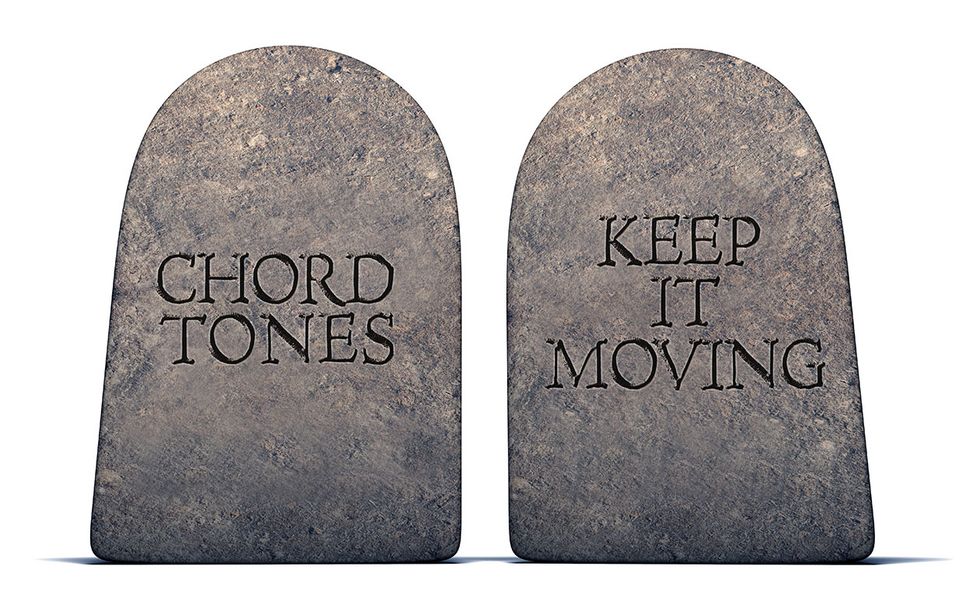Theory: Intermediate
Lesson Overview:
• Understand how to phrase “outside” notes.
• Learn how to add tension to speedy passages.
• Strengthen your alternate-picking technique. Click here to download a printable PDF of this lesson's notation.
In my earlier years as a guitarist, I was intimidated by the idea of expanding musical lines with notes that weren’t in the scale that was diatonic to the progression or chord I was playing over. What helped me get pass this fear? Studying how some of my favorite players incorporate non-diatonic notes in a systematic way. In this lesson, I’ll share some of the ideas I discovered. We’ll explore the concept of chromatic playing and see how you can include non-diatonic notes in your phrases. I’ll examine how a couple of my favorite players have used the chromatic concept—Steve Morse (Dixie Dregs and Deep Purple) and Ian Thornley (Big Wreck). I’ll also show you an example of how I incorporated chromatic playing into a solo from one of the songs on my latest album. Okay, let’s get started.
First off, let’s define the term chromatic. A quick internet search gives us this definition: Music relating to or using notes not belonging to the diatonic scale of the key in which a passage is written.
When we think of using notes that are outside of a given key, it’s easy to think they sound wrong or that we’ve made a mistake. Well, that could be the case, but it’s also possible to use those “outside” notes in a musical way. So how do we use chromatic notes musically? One way is to use chromatic notes to “fill in” spaces between the diatonic scale tones.
For instance, if we were playing an A minor pentatonic (A–C–D–E–G) scale, it would be easy to simply fill in the notes between the root (A) and the b3 (C). An important thing to remember: Don’t dwell on the chromatic, or outside, notes. Instead, emphasize the diatonic notes.
You can accomplish this by playing chromatics with shorter note values or just as part of a faster musical line. Aim to land on the diatonic notes on important rhythmic points in your musical lines—possibly on downbeats or even the “and” of a beat when dealing with 16th- or 32nd-note passages.
Using some musical examples, let’s take a look at how the aforementioned players handle this.
First up is the incredible Ian Thornley. We’ll dissect a musical line reminiscent to a phrase from his solo on the Big Wreck song “A Million Days.” In Ex. 1, I simply outline the G# minor pentatonic (G#–B–C#–D#–F#) scale that Ian seems to be using as a foundation for the solo.
Click here for Ex. 1
Ex. 2 illustrates how he fleshes out the musical idea by using many chromatic notes. Ian does two things: He plays the chromatic tones very quickly and doesn’t dwell on any of them. Also, he lands the diatonic notes on the more important beats. Because he’s playing the line using 16th-note sextuplets, those points would be the first and fourth note of each group of six. Only once does he play a chromatic note on an important beat, but he gets away with it because of the sheer speed of the line.
Click here for Ex. 2
Now let’s see how Steve Morse uses similar concepts. I’ve chosen several lines similar to what he plays in “Simple Simon.” In Ex. 3, I simply outline the G minor pentatonic (G–Bb–C–D–F) pattern that underlies the next phrase.
Click here for Ex. 3
Ex. 4 shows how Steve uses the concepts we’ve discussed. One interesting point: Steve adds tension to the first 16th-note line by starting on C# over the C5. This creates a unique sound, and since Steve keeps this line moving until ultimately resolving by landing firmly on G, it works out well. In the faster sextuplet line that closes out the example, Steve passes very quickly through the chromatic notes and lands the diatonic notes on the important beats.
Click here for Ex. 4
The final musical examples are from “Twisted Impression,” a song from my latest album, Brief Eclipse. In Ex. 5 and Ex. 6, I outline the scale fragments of A minor pentatonic and A Dorian (A–B–C–D–E–F#–G) that I use as my foundation scales.
Click here for Ex. 5
Click here for Ex. 6
In Ex. 7, we have an Am–C progression with a long 32nd-note line that uses the same two principles that popped up in Steve and Ian’s lines: chord tones on strong beats and keep it moving!
Click here for Ex. 7
Ex. 8 demonstrates a simple A minor pentatonic shape that’s great to have under your fingers.
Click here for Ex. 8
Finally, Ex. 9 is a pretty twisted line that wraps up everything we’ve talked about in this lesson. Even though we’re hearing a stream of 32nd-notes, our ears latch onto the tones that land on the strong pulses.
Click here for Ex. 9
I hope these examples can help you incorporate chromatic sounds into your soloing and spark some new and inspiring ideas.



















